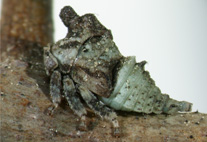Abstract
Recent research on the treehopper tribe Telamonini has focused on their classification and Nearctic distribution but little has been published on their biology, including detailed information on their host plants as well as data on their nymphal stage. Any studies including host plant data have emphasized adult records (often unreliable due to their movements), largely ignoring the nymphs, which are the predominant feeding stage. This work provides the first comprehensive summary of Telamonini host plants, it documents the first positive identification of the nymphs for several telamonine species (and the genus Helonica), and it provides the first morphological diagnoses for 14 species, thus filling in major gaps in the life history of many species. Host plant records were determined based on accounts in the literature (adults and nymphs), from rearings of nymphs on host plants to the adult stage, and from label data on museum specimens. The Telamonini are known from 22 families, 41 genera, and 80 species of mostly woody, deciduous trees (of which, six species are new host plant records). Nearly half of all telamonines have been collected from more than one plant genus and only 12 species are known from a single host plant species. Telamonine nymphs were reared to the adult stage on 15 plant species. Of 68 telamonine species, 45 have been found on oak (Quercus), and white oak (Q. alba) is the most common telamonine host plant. Telamona monticola has the most recorded host plants with 29. The work includes 23 color illustrations showing both live and preserved nymphs, representing 15 species, all illustrated for the first time (eight are positively identified for the first time). Differences in nymphal morphology among species within Archasia, Glossonotus, Heliria, and Telamona suggest current generic definitions need revision. This study highlights the need for an increased emphasis on nymphal collections when determining treehopper host plants and inferring classifications.

